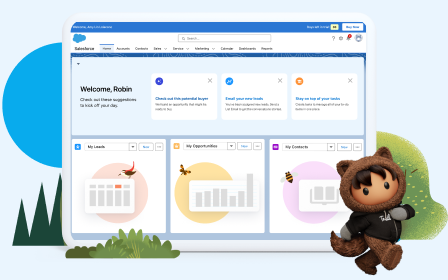Prepare for Demos and Presentations
Learning Objectives
After completing this unit, you’ll be able to:
- Describe the purpose of presentations and demos.
- Explain why to plan for a presentation or demo.
- Identify and cover differentiators in your presentation or demo.
- Identify ways to cater your presentation to your customer.
- Describe the zones of attention and despair.
Demo Your Way to Success
What comes to mind when you think about demoing solutions to customers? Demos are commonly thought of as showing products to customers to persuade them to buy.
But presentations and demos are that and so much more. They’re also opportunities.
- They deepen your relationship with your customer.
- They show value that’s important to your customer.
- They present messages that speak directly to your customer.
- They target your customer’s pain points while showing our solution.
- They differentiate your company and solutions from the competition.
- They explain how your company helps customers succeed.
A Planner’s Survival Guide
The most important component of a successful presentation is planning. Your success is directly related to how effectively you do the following.
- Prepare your strategy.
- Identify what’s most important to your customer.
- Use tools such as demo environments that give you an advantage in the field.
Think of planning a presentation like taking a group trip to the amusement park. You arrive at the park, ready to begin your day with your favorite attraction—the haunted house—only to feel a slight sense of disappointment as you realize that it’s closed for maintenance. We don’t want you to go to the park and get caught off guard. So don’t walk through those turnstiles without a game plan. For your trip—as for your presentation—to be a success, plan ahead.
The more you prepare, the better equipped you are.
- Focus your presentation on what matters most to your customer.
- Respond to issues as they pop up.
- Visualize processes, concepts, or reference stories that serve as powerful proof points.
- Talk to your customer about pain points and opportunities affecting their business.
- Engage potential team members—such as demo engineers or specialists—early.
Find the Differentiation
One way to tailor your presentation to your audience is deep customer-centric discovery; give your customer a compelling reason to make a change. This is called differentiation, and it’s an important part of planning for your presentation. A customer’s decision to do nothing is the biggest reason you lose deals. Change is hard;it’s often easier to stay the same.
Differentiation shows your customer why your solution is more compelling than their present state or what competitors deliver. Customer-centric discovery gives you the perfect opportunity to uncover your customer’s business goals and pain points. By using this information, you can deliver differentiation with real business benefits.
Attention = Retention
What’s worse than missing your favorite ride at an amusement park? Presenting a long-winded, monotonous presentation.
As you plan your presentation, keep in mind that you have to grab and keep your audience’s attention for them to act on your messages afterward. Think about it. If your customer doesn’t remember what you presented, then how can they act?
The attention-retention curve shows how audiences respond to presentations. It’s broken into two parts.
- The zone of attention: The time period during the presentation when you have your audience’s attention.
- The zone of despair: The time period during the presentation when your audience is least likely to pay attention.
The zone of attention is crucial to think about as you plan. For the first 3 to 5 minutes of your presentation, 70 to 90 percent of your audience is paying attention. For the last 2 to 3 minutes, 90 to 100 percent of your audience is paying attention.
Now, let’s look at the middle portion of your presentation, which can turn into a zone of despair if you’re not careful. This is usually where you spend most of your preparation time. Unfortunately, it’s also the time when your audience is most likely daydreaming, thinking about the upcoming weekend, or what’s for lunch. Both your challenge and your opportunity is to craft and deliver a presentation that retains an audience’s attention and avoids the zone of despair.
When you plan your presentation, keep these tips in mind to maximize the time when your audience is paying the most attention:
| Do |
Don’t |
|---|---|
|
Use discovery to tailor your presentation to focus on your customer’s top priorities. |
Overcomplicate things. Complexity slows down or kills deals, causing your customer to freeze, do nothing, or run away. |
|
Make things visual; people process visual information 60,000 times faster than text. |
Start with your name and title. |
|
Validate how you’re going to solve your customer’s issues. |
Launch with the corporate pitch. |
|
Plan ways to entertain and engage your audience. |
Start by talking about how great Salesforce is before solving your customer’s problems. |
|
Plan the overall presentation with your entire team. |
Plan a generic, feature-focused demo. |
|
Keep a clear end in mind. |
Present without preparing. |
|
Discuss who owns each piece of the presentation. |
Neglect to find ways to create moments of attention during the zone of despair. |

